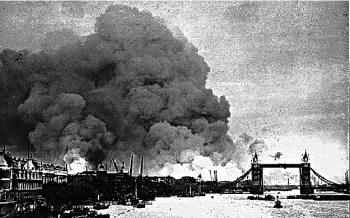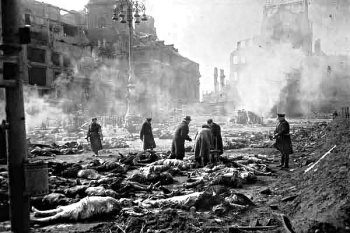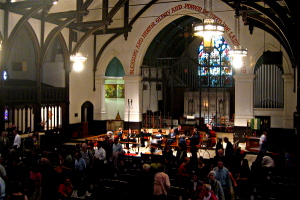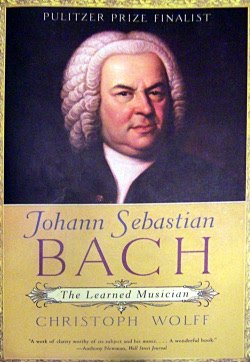Another busy couple weeks, but I did manage to finish John Brandon’s first novel, Arkansas. I wasn’t as impressed with it as I have been with many of the McSweeney’s books introducing new authors, but that’s not to say it wasn’t a good book. It’s about small time crime in Arkansas, and sitting here recalling the characters and plot, it suddenly occurs to me that the Cohen brothers could make a great film out of it. I hadn’t drawn that connection while I was reading it, but now that I’m done I realize the book has a genuine sense of place that’s part of the good Cohen movies, and the two main characters often talk right past each other in a way that reminds me of the characters in Blood Simple. Plus: odd violence that’s not necessarily expected at the time it happens.
It’s probably not going to stick with me the way Icelander or The Children’s Hospital did, but I can certainly recommend it. And not insignificantly, it’s a beautifully produced hardcover with a sewn binding and some nice gold leaf on the cover.
The Wind-Up Bird Chronicle is Haruki Murakami’s most well regarded book, and the first of his books I’ve read. I’m sure I will be reading more. It reminded me a lot of Paul Auster, another of my favorite authors. In both author’s books, reality is often in question, there are many threads to the story that are often tied up together in unlikely ways, and characters suffer strange fates in isolating places.
Here, the book begins with the out-of-work main character looking for his cat, taking care of the house while his wife is at work. As the story progresses, stranger and stranger things start happening to him, and eventually, you wonder which parts of the story are real and what parts are imagined. But unlike many stories like this, very little suspension of disbelief is required.
I enjoyed everything about the book. The historical digressions into Japan’s wartime campaign in Manchuria were fascinating after reading Human Smoke, it was good to read a book with women in it for a change (I’ve been reading a lot of dry non-fiction recently), and as someone taking a vacation between jobs, I really identified with the main character and his struggles to understand the world around him and where he fit into it.
Highly recommended.

london burning, sep 1940
The afterword and dedication of Human Smoke: The Beginnings of World War II, the End of Civilization tells you a lot about the perspective Nicholson Baker has in telling the story of World War II up to January 1942:
This book ends on December 31, 1942. Most of the people who died in the Second World War were at that moment still alive. Was it a “good war”? Did waging it help anyone who needed help?
. . .
I dedicate this book to the memory of Clarence Pickett and other American and British pacifists. They’ve never really gotten their due. The tried to save Jewish refugees, feed Europe, reconcile the United States and Japan, and stop the war from happening. They failed, but they were right.
Whether or not a different approach to the “Great War” would have helped those who needed help cannot be answered, but after reading this book you will truly see how horrifying the war was, and how those who waged it contributed to it’s horrors. That the title of the book refers to the smoke from the incinerators at Auschwitz should be enough to give you pause over whether you want to read this book. It’s pretty devastating. But it does serve as a powerful antidote to the false historical idea that the Allies fought the good fight to liberate the world from the Axis evil. There’s not much good in war, even a “necessary” war like World War II, and there was plenty of evil among all leaders engaged in the struggle.
I found three main threads in the book. First, and probably most important was the nature of the way the war was brought to the citizens of Europe. Cities on both sides were bombed using brutal techniques that typically started with incendiary bombs to set blacked-out targets on fire, followed by high energy exposives targeting the fires themselves (if it’s burning, it must be something worth destroying), and ending with delayed-action bombs “so as to prevent or seriously interfere with fire fighting, repair and general traffic organization” (from a British Air Ministry report on bombing policy, April 24, 1941). Churchill is quoted several times using the phrase “Business before Pleasure” to describe targeting military targets before civilian ones. Despite this intention, the vast majority of British and German bombs fell on citizens, not military targets. The British blockade of Europe also brought the war to Axis countries in the form of famine. Churchill explained that fats make bombs and potatoes make synthetic fuels that would be used against Britain. Herbert Hoover wrote: “The notion that the special type of food we needed for children (milk, chocolate, fats, and meat) would be used for munitions was sheer nonsense.” As in Bush’s war in Iraq, Hoover quotes the old adage: truth is war’s first fatality.

dresden firebombing, feb 1945
The second main thread concerns the plight of the Jews. It appears from the quotes in this book as though Hitler’s main objective was to remove the Jews from Europe, and when he could find no place to send them (including Palestine, Madagascar and any other country willing to take them), he began his program of extermination. Again, there’s no way to know what might have happened if the Allies had offered refuge to the Jews in Axis countries, but it’s hard to imagine anything worse than what happened.
The final argument working through the book is the ways in which the United States goaded the Japanese into their pre-emptive strike on Pearl Harbor. Without all the evidence, it’s hard to decide if this is a valid argument, but it is clear that the United States had many opportunities to relax tensions with Japan and prevent a Pacific war. Instead we were supplying the Chinese and Soviets with bombers, fuel, pilots and training, while at the same time, building up our own bases surrounding Japan. Churchill seemed convinced that the United States would enter the war once the Germans started bombing England, and then when France fell, but it took the attack on Pearl Harbor to get us in. Baker’s book has something to say about how that happened.
These three main arguments, and others, weave their way through the book’s chronologically arranged short presentations of facts. It’s a very effective way to make a simple argument about the nature of war, and despite the horrors on the page, it’s an entertaining way to receive history. The problem is that without any objective (or even subjective) interpretation of the passages, or a stated intention toward balance and objectivity, it’s hard to evaluate the arguments that formed in my mind. I have no doubt about the facts Baker includes, but there are likely to be facts that don’t follow the general patterns on display. Nevertheless, if you’re interested in what lead up to the entry of the United States into World War II, or if you have doubts about the heroic storyline presented in the multitude of “Great War” documentaries, this book should be included alongside more traditional historical accounts of the war.
bach concert, washington dc
photo by eye captain
Introduction
I’d never even heard of a cantata before getting the set of Bach CDs, but if one is to believe the following quote, they’re a very important part of Bach’s music:
Bach’s greatest achievement is the Cantata Project, the five annual cycles which he began when he came to Leipzig and finished five years later. Because of losses in manuscripts and only the barest suggestion of the overriding design, we are probably doomed to see this monument as a series of individual works rather than a mighty collection of 300 parts with hundreds of movements.
Douglas Cowling, 2007-May-06, Bach Cantatas mailing list
I’m starting my cantata listening with the three works written for the first week in Advent, which was last Sunday, and happens to be the beginning of the church year. I doubt if I’ll be able to listen to all of Bach’s cantatas in order, but I’ve listed the upcoming dates for all the cantatas, the place of all of Bach’s works on the Bach Edition CDs, as well as my progress listening to them on this page.
Here, I’m listening to cantata 61 from CD III-1, cantata 62 from III-28, and cantata 36 from IV-5. They’re all conducted by Pieter Jan Leusink and the Netherlands Bach Collegium with the Holland Boys Choir. Soloists include Ruth Holton (soprano), Sytse Buwalda (alto), Nico van der Meel (tenor) and Bas Ramselaar (bass). In reading reviews of Leusink’s complete cycle, many commentators seem to specifically dislike Buwalda, and complain that Leusink’s interpretations aren’t very considered. Leusink recorded the entire set of Bach’s cantatas in a single year, and the reviews usually mention this as a possible reason for why his cycle isn’t as polished and “correct” as other cycles. I haven’t been listening to cantatas long enough to really know if these complaints are valid or not.
I also downloaded Philippe Herreweghe’s Adventskantaten CD from eMusic. It’s got the same three cantatas on it, and Herreweghe’s cantata recordings are highly regarded by the same people who aren’t all that fond of Leusink, so it should be a good comparison.
I’m using several references to guide my listening. First, and foremost is the Bach Cantatas website. They’ve got commentary culled from the mailing list of the same name for all the cantatas and many of Bach’s other works. For a mailing list, there’s an amazing diversity of very expert opinion on all aspects of Bach’s music. Second is Simon Crouch’s Listening Guide to Bach’s Cantatas, which provides a short summary of all the cantatas and his opinions on them. Finally, I borrowed a copy of W. Gillies Whittaker’s two volume The Cantatas of Johann Sebastian Bach from the library. It’s out of print, but is available from used booksellers for a reasonable price. It’s a pretty detailed look at each cantata, but it suffers a bit because it doesn’t reflect recent scholarship regarding Bach. Alfred Dürr’s The Cantatas of J.S. Bach is apparently the best source of contemporary information, and it includes parallel German / English translations for all the cantatas, but none of the local libraries have a copy, and a new paperback is more than $70 from amazon.com. Sight unseen, that’s an awfully expensive book, but if I really get into the cantatas, maybe it’ll be worth it.
I’ve listened to these three cantatas more than 30 times in the last week and a half, so it’s time to write about them and move on to something else.
Cantata BWV 61, Nun komm, der Heiden Heiland (Come thou blessed Savior, come)
This cantata was first performed December 2, 1714 in Weimar. Bach held the title of concertmeister at the time, and was formally required to compose new church music once a month. This cantata is also known to have been performed November 28, 1723 in Leipzig .
The first movement starts with a great chorus, with violins and other stringed instruments playing the melody from Martin Luther’s hymn, which names the piece. It’s a great introduction to the work, and for me, to the cantata form.
Next is a recitative sung by the tenor backed by a violin and organ, followed by an aria that’s also sung by the tenor. According to the Wikipedia, the difference between a recitative and an aria is how speech-like the rhythm of the vocal accompaniment is, and I guess in that context the tenor is really singing the third movement in time with the melody, rather than speaking over it as he does in the second movement. It’s cool to have one follow the other with the same singer so I can hear the difference between them.
The fourth movement is another recitative, but this time the strings are plucked (pizzicato). The passage being sung comes from Revelations 3:20: “Here I am! I stand at the door and knock.” and the plucked strings is meant to evoke the sound of Jesus knocking. It sounds a bit like a foolish compositional trick, but it really does work, especially at the point in the music. I’ve always disliked Aaron Copland’s Appalachian Spring because of the clopping sounds meant to evoke the sound of horses, but I don’t mind Bach’s use of pizzicato here.
The work concludes with a beautiful soprano aria and an absolutely fantastic chorale. I like the last movement best; it’s really joyful. Unfortunately, it’s also really short, and to me, seems to end the cantata prematurely.
As far as the two different recordings I have (Leusink and Herreweghe), the timing differs between the two works, but the instrumentation, singing and expressiveness of the piece are very similar between the two. I really can’t complain about either, and I don’t know if I would even be able to recommend one over the other. This surprises me a little bit because most of the commentary I’ve read about Leusink and the singers have placed his versions near the bottom of the available choices. Not so in my ears!
Cantata BWV 62, Nun komm, der Heiden Heiland (Come thou blessed Savior, come)
Cantata 62 was first performed on December 3, 1724 in Leipzig as part of Bach’s second annual cycle of cantatas. He wrote five complete cycles during his first years as capellmeister at the St. Thomas School (an incredible output given all the performances, practice and other labors he was required to do in addition to essentially composing a new work each week), but unfortunately most of the last two cycles have been lost.
This cantata is based on the same hymn as 61 and has a similar structure of a chorus, an alternating series of arias and recitatives, and a final chorus. Compared to 61, I like the opening chorus even more because it seems like the instrumental part has more of a chance to develop before the chorus comes in, making it that much more dramatic. There’s also a lot of counterpoint among the singers that I like.
Next we’ve got a tenor aria, bass recitative, and bass aria. Only the bass aria is interesting because of the strong instrumentation. For this movement, I do prefer Herreweghe’s version over Leusink because it’s very forcefully played and sung. Leusink seems to drag it out and it loses a lot of it’s power.
The final recitative before the closing chorus is a duet for the soprano and alto singers, which makes it different from the movements thus far. The chorus for this cantata is even shorter than the chorus of cantata 61, but it’s also not as good. The best part of this cantata is the opening chorus, by a long shot.
I like Herreweghe’s version quite a bit more for this cantata, mostly due to the quickened pacing which makes it brighter and more urgent sounding. The opening chorus and the bass aria really benefit from the faster timing.
Cantata BWV 36, Schwingt freudig euch empor (Swing joyfully yourselves on high)
This sacred version of cantata 36 comes from Bach’s reworking of several secular cantatas (versions 36b and 36c still exist) and was first performed December 2, 1731.
Here we have a completely different pattern, with an opening chorus, followed by alternating chorales and arias. Like the other Advent cantatas (maybe cantatas in general?) it ends with a chorale. There are no recitatives here, which is apparently unusual, but for me is a welcome change.
The opening chorus has a lot of the counterpoint I like from the opening of cantata 61, but here the instrumentation features woodwinds (Oboe d’amore) rather than strings carrying the melody. The rest of the cantata carries along similarly to the chorus, with a variety of duets, arias and chorales and more woodwind accompaniment. The melody is very simple and is easy to pick out throughout the work.
I like the soprano aria in the seventh movement not so much because of the singing, but because the voice and the featured violin (violone?) complement each other very well.
Similar to cantata 62, Leusink is slower and more leisurely than Herreweghe. That works well for the soprano aria, but not so well for the opening chorus. I also like Leusink’s soprano (Ruth Horton) more than Sibylla Rubens. Horton sings more gracefully and emotionally, while Rubens really belts it out like an opera singer. I think the aria needs a lighter touch. Anyway, it’s a mixed bag here and I can’t outright recommend one version over the other. And in general, I don’t think you can go wrong with either recording. The music is too good.
Along with listening to all of Bach’s extant music via the Bach Edition I wanted to learn more about the man, and hopefully understand the music a little bit better. Johann Sebastian Bach was born in 1685 to a musical family in Eisenach. By the time he was eighteen he was a respected organologist and received appointments as church organist first in Arnstadt (in 1703) and then in Mühlhausen (1707). In 1708 he was appointed organist and chamber musician in Weimar, and later became concertmaster there. His next position was in Cöthen from 1717 to 1723 where he served as capellmeister. His final position was as cantor at St. Thomas School in Leipzig where he remained until his death in 1750. Along the way he was married twice (his first wife died in 1720) and had twenty children, ten of whom survived into adulthood.
Christoph Wolff’s biography is a very good scholarly introduction to what we know about Johann Sebastian Bach. Wolff is a well respected Bach expert, directing the Bach-Archiv in Leipzig and author and editor of many other Bach publications. This expertise really comes through in the book, which is filled with scholarly discussion and excerpts from what little remains from Bach’s life. Because most of Bach’s letters, writings and music are gone, a biography of Bach is more like a series of reasoned hypotheses that can never be fully rejected. Wolff does an excellent job leading us through these arguments.
I was most surprised by how much of Bach’s life is simply unknowable because so much of what he wrote, both musically and personally, has been lost. He wrote five complete cantata cycles during his first years in Leipzig, but almost all of the final two series are lost. And the lack of personal writings means that we know almost nothing about how Bach lived his life day to day, or what he thought about his music. Wolff writes in his introduction:
Bach’s biography suffers from a serious lack of information on details, many of them crucial… Indeed, it would not be difficult to devote entire chapters to what it not known about Bach’s life. Thus, conjectures and assumptions are unavoidable, and this book necessarily calls for numerous occurrences of “probably,” “perhaps,” “maybe,” and the like. Yet, as I try to demonstrate in these pages, it is not impossible to reveal, even in the case of Bach, the essence of a life.
He goes on to say that what we do know about him comes to us in the form of his music, music which Bach used to explore the boundaries of what was known about musical science at that time. Although I lack the musical training to understand what was so revolutionary about Bach’s explorations (for example, writing about The Well-Tempered Clavier, Wolff writes “In demonstrating that the tonal system could be expanded to twenty-four keys not just theoretically but practically, Bach set a milestone in the history of music whose overall implications for chromatic harmony would take another century to be fully realized.”), Wolff’s analyses of Bach’s music in the book only increases my appreciation for Bach’s music.



